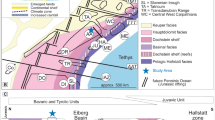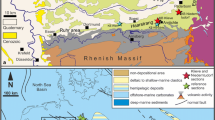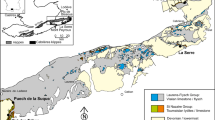Abstract
The Upper Cenomanian–Lower Turonian litho-stratigraphic units of the Danubian Cretaceous Group of the proximal Bodenwöhrer Senke (Regensburg, Eibrunn and Winzerberg formations, the latter consisting of a lower Reinhausen Member and an upper Knollensand Member), have been investigated with a focus on facies analysis and sequence stratigraphy. Analyses of litho-, bio-, and microfacies resulted in the recognition of 12 predominantly marine facies types for the Eibrunn and Winzerberg formations. Petrographic and paleontological properties as well as gradual transitions in the sections suggest that their depositional environment was a texturally graded, predominantly siliciclastic, storm-dominated shelf. The muddy–siliceous facies types FT 1–3 have been deposited below the storm wave-base in an outer shelf setting. Mid-shelf deposits are represented by fine- to medium-grained, bioturbated, partly glauconitic sandstones (FT 4–6). Coarse-grained, gravelly and/or shell-bearing sandstones (FT 7–10) developed in the inner shelf zone. Highly immature, arkosic coarse-grained sandstones and conglomerates (FT 11 and 12) characterize an incised, high-gradient braided river system. The Winzerberg Formation with its general coarsening- and thickening-upward trend reflects a regressive cycle culminating in a subaerial unconformity associated with a coarse-grained, gravelly unit of marine to fluvial origin known as the “Hornsand” which is demonstrably diachronous. The overlying Altenkreith Member of the Roding Formation signifies the onset of a new transgressive cycle in the early Middle Turonian. The sequence stratigraphic analysis suggests that the deposition of the Upper Cenomanian and Lower Turonian strata of the Bodenwöhrer Senke took place in a single cycle of third-order eustatic sea-level change between the major sequence boundaries SB Ce 5 (mid-Late Cenomanian) and SB Tu 1 (Early–Middle Turonian boundary interval). The southeastern part of the Bodenwöhrer Senke was flooded in the mid-Late Cenomanian (Praeactinocamax plenus transgression) and a second transgressive event occurred in the earliest Turonian. In the central and northwestern parts of the Bodenwöhrer Senke, however, the initial transgression occurred during the earliest Turonian, related to pre-transgression topography. Thus, the Regensburg and Eibrunn formations are increasingly condensed here and cannot be separated anymore. Following an earliest Turonian maximum flooding, the Lower Turonian Winzerberg Formation filled the available accommodation space, explaining its constant thickness of 35–40 m across the Bodenwöhrer Senke and excluding tectonic activity during this interval. Rapid sea-level fall at SB Tu 1 terminated this depositional sequence. This study shows that Late Cenomanian–Early Turonian deposition in the Bodenwöhrer Senke was governed by eustatic sea-level changes.












Similar content being viewed by others
References
Boulila S, Galburn B, Miller KG, Pekar SF, Browning JV, Laskar J, Wright JD (2011) On the origin of Cenozoic and Mesozoic “third-order” eustatic sequences. Earth Sci Rev 109:94–112
Brunhuber A (1917) Die geologischen Verhältnisse von Regensburg und Umgebung. Naturwissenschaftlicher Verein, Regensburg, p 107
Caron M (1985) Cretaceous planktic foraminifera. In: Bolli HM, Saunders JB, Perch-Nielsen K (eds) Plankton stratigraphy. Cambridge University Press, Cambridge, pp 17–86
Čech S, Klein V, Křiž J, Valečka J (1980) Revision of the Upper Cretaceous stratigraphy of the Bohemian Cretaceous Basin. Věst Ŭst Ustav Geol 55:277–295
Einsele G (2000) Sedimentary basins—evolution, facies and sedimentary budget. Springer, Berlin, p 792
Elrick M, Berkyova S, Klapper G, Sharp Z, Joachimski M, Fryda J (2009) Stratigraphic and oxygen isotope evidence for My-scale glaciation driving eustasy in the Early–Middle Devonian greenhouse world. Palaeogeogr Palaeoclimatol Palaeoecol 276:170–181
Fay M (1983) Sedimentologie und Paläogeographie der tieferen Oberkreide in Ostbayern. Berliner Geowiss Abh A 49:1–57
Förster R, Meyer R, Risch H (1983) Ammoniten und planktonische Foraminiferen aus den Eibrunner Mergeln (Regensburger Kreide, Nordostbayern). Zitteliana 10:123–141
Gale AS (1995) Cyclostratigraphy and correlation of the Cenomanian stage in Western Europe. In: House MR, Gale AS (eds) Orbital forcing timescales and cyclostratigraphy. Geol Soc London Spec Publ 85:177–197
Gale AS (1996) Turonian correlation and sequence stratigraphy of the Chalk in southern England. In: Hesselbo SP, Parkinson DN (eds) Sequence stratigraphy in British geology. Geol Soc London Spec Publ 103:177–195
Gale AS, Kennedy WJ, Voigt S, Walaszczyk I (2005) Stratigraphy of the Late Cenomanian–Early Turonian Chalk succession at Eastbourne, Sussex, UK: ammonites, inoceramid bivalves and stable carbon isotopes. Cret Res 26:460–487
Gradstein FM, Ogg JG, Smith AG (2004) A geologic time scale 2004. Cambridge University Press, Cambridge, p 589
Gümbel CW von (1868) Geognostische Beschreibung des Koenigreichs Bayern. 2. Abtheilung, Geognostische Beschreibung des Ostbayerischen Grenzgebirges oder des Bayerischen und Oberpfälzer Waldgebirges. Justus Perthes, Gotha, p 968
Hinnov LA (2000) New perspectives on orbitally forced stratigraphy. Ann Rev Earth Planet Sci 28:419–475. doi:10.1146/annurev.earth.28.1.419
Jago CF, Barusseau JP (1981) Sediment entrainment on a wave-graded shelf, Roussillon, France. Mar Geol 42:279–299
Johnson DW (1919) Shore processes and shoreline development. Wiley, New York, p 584
Korsitzke H-D (1995) Planktonische Foraminiferen der Oberkreide (Cenoman–Campan) am nördlichen Tethysrand (süddeutscher Molasse-Untergrund, Regensburger Kreide)—Systematik, Stratigraphie sowie Palökologie der Foraminiferengesamtfauna. Docum Natur 92:1–274
Laskar J, Robutel P, Joutel F, Gastineau M, Correia ACM, Levrard B (2004) A long-term numerical solution for the insolation quantities of the Earth. Astronom Astrophys 428:261–285
Meyer RKF (1989) Die Entwicklung der Kreide-Sedimente im Westteil der Bodenwöhrer Senke. Erlanger Geol Abh 117:53–96
Meyer RKF (1996) Kreide. In: Freudenberger W, Schwerd K (ed) Erläuterungen zur Geologischen Karte von Bayern 1:500000. GLA, München, pp 112–125
Meyer RKF, Mielke H (1993) Erläuterungen zur Geologischen Karte von Bayern 1:25000, Blatt Nr. 6639 Wackersdorf. GLA, München, p 194
Meyers SR, Siewert SE, Singer BS, Sageman BB, Condon DJ, Obradovich JD, Jicha BR, Sawyer DA (2012) Intercalibration of radioisotopic and astrochronologic time scales for the Cenomanian–Turonian boundary interval, Western Interior Basin, USA. Geology 40:7–10. doi:10.1130/G32261.1
Miall AD (1996) The geology of fluvial deposits: sedimentary facies, basin analysis and petroleum geology. Springer, Berlin, p 582
Nagm E (2009) Integrated stratigraphy, palaeontology and facies analysis of the Cenomanian–Turonian (Upper Cretaceous) Galala and Maghra el Hadida formations of the western Wadi Araba, Eastern Desert, Egypt. PhD thesis, Würzburg University, Würzburg. http://www.opus-bayern.de/uni-wuerzburg/volltexte/2009/3988/
Nagm E, Wilmsen M, Aly M, Hewaidy A (2010) Biostratigraphy of the Upper Cenomanian–Turonian (lower Upper Cretaceous) successions of the western Wadi Araba, Eastern Desert, Egypt. Newsl Stratigr 44:17–35
Niebuhr B (2011a) Die Bohrung Pfakofen LAM B2/09 südlich von Regensburg (Turonium/Coniacium-Grenzbereich)—ein Beitrag zur Stratigraphie der Danubischen Kreide-Gruppe (Bayern, Süd-Deutschland). Geol Bl NO Bayern 61:97–116
Niebuhr B (2011b) Vergessene Kreide—Verkieselungen in der „lehmigen Albüberdeckung“ der Südlichen Frankenalb (Bayern). Freiberger Forsch H C 540:47–63
Niebuhr B, Hiss M, Kaplan U, Tröger K-A, Voigt S, Voigt T, Wiese F, Wilmsen M (2007) Lithostratigraphie der norddeutschen Oberkreide. SDGG 55:1–136
Niebuhr B, Pürner T, Wilmsen M (2009) Lithostratigraphie der außeralpinen Kreide Bayerns. SDGG 65:7–58
Niebuhr B, Wilmsen M, Chellouche P, Richardt N, Pürner T (2011) Stratigraphy and facies of the Turonian (Upper Cretaceous) Roding Formation at the southwestern margin of the Bohemian Massif (southern Germany, Bavaria). ZDGG 62:295–316
Niebuhr B, Richardt N, Wilmsen M (in press) Facies and integrated stratigraphy of the Upper Turonian (Upper Cretaceous) Großberg Formation south of Regensburg (Bavaria, southern Germany). Acta Geol Polon
Philip J, Floquet M (2000) Late Cenomanian (94.7–93.5). In: Dercourt J, Gaetani M, Vrielynck B, Barrier E, Biju-Duval B, Brunet MF, Cadet JP, Crasquin S, Sandulescu M (eds) Atlas Peri-Tethys, Palaeogeographical Maps. CCGM-CGMW, Paris, pp 129–136
Richardt N (2010) Das Cenoman im Teutoburger Wald bei Halle/Westfalen (NW-Deutschland): Eine integrierte stratigraphisch-sedimentologische, mikrofazielle und geophysikalische Analyse. Geol Paläont Westf 78:5–60
Richardt N, Wilmsen M (2012) Lower Upper Cretaceous standard section of the southern Münsterland (NW Germany): carbon stable-isotopes and sequence stratigraphy. Newsl Stratigr 45:1–24
Robaszynski F, Juignet P, Gales AS, Amédro F, Hardenbol J (1998) Sequence stratigraphy in the Cretaceous of the Anglo-Paris Basin, exemplified by the Cenomanian stage. In: de Graciansky P, Hardenbol J, Jaquin T, Vail PR (eds) Mesozoic and Cenozoic sequence stratigraphy of European basins. Soc Econ Palaeont Miner Spec Publ 60:363–385
Sageman BB, Meyers SR, Arthur MA (2006) Orbital time scale and new C-isotope record for Cenomanian–Turonian boundary stratotype. Geology 34:125–128
Sharland PR, Archer RP, Casey DM, Davies RB, Hall SH, Heward AP, Horbury AD, Simmons MD (2001) Arabian Plate sequence stratigraphy. Geoarabica Spec Publ 2:1–371
Swift DJP, Heron SD, Dill CE (1969) The Carolina Cretaceous: petrographic reconnaissance of a graded shelf. J Sediment Res 39:18–33
Tröger K-A (2003) The Cretaceous of the Elbe valley in Saxony—a review. Carnets Géol A03:1–14
Tröger K-A, Niebuhr B, Wilmsen M (2009) Inoceramen aus dem Cenomanium bis Coniacium der Danubischen Kreide-Gruppe (Bayern, Süd-Deutschland). SDGG 65:59–110
Uličný D, Špičáková L (1996) Response to high frequency sea-level change in a fluvial to estuarine succession: Cenomanian palaeovalley fill, Bohemian Cretaceous Basin. In: Howell JA, Aitken JF (eds) High resolution sequence stratigraphy: innovations and applications. Geol Soc London Spec Publ 104:247–268
Uličný D, Hladíková J, Hradecká L (1993) Record of sea-level changes, oxygen depletion and the δ13C anomaly across the Cenomanian–Turonian boundary, Bohemian Cretaceous Basin. Cret Res 14:211–234
Uličný D, Hladíková J, Attrep MJ, Čech S, Hradecká L, Svobodová M (1997) Sea-level changes and geochemical anomalies across the Cenomanian–Turonian boundary: Pecínov quarry, Bohemia. Palaeogeogr Palaeoclimatol Palaeoecol 132:265–285
Uličný D, Laurin J, Čech S (2009) Controls on clastic sequence geometries in a shallow-marine transtensional basin: the Bohemian Cretaceous Basin, Czech Republic. Sedimentology 56:1077–1114
Voigt T (1999) Ablagerungsbedingungen und Taphonomie der Schmilka-Formation (Unter-Turon) südlich von Pirna (Sächsisches Kreidebecken). Greifswalder Greifsw Geowiss Beitr 6:193–207
Voigt T, Tröger K-A (1996) Sea-level changes during the Late Cenomanian and Early Turonian in the Saxonian Cretaceous Basin. Mitt Geol Paläont Inst Univ Hamburg 77:275–290
Voigt S, Gale AS, Voigt T (2006) Sea-level changes, carbon cycling and palaeoclimate during the Late Cenomanian of northwest Europe; an integrated palaeoenvironmental analysis. Cret Res 27:836–858
Voigt S, Erbacher J, Mutterlose J, Wonik T, Westerhold T, Wiese F, Wilmsen M, Weiss W (2008) The Cenomanian/Turonian of the Wunstorf section (N Germany): global stratigraphic reference section and new orbital time scale for Oceanic Anoxic Event 2. Newsl Stratigr 43:65–89
Wiese F (2009) The Söhlde Formation (Cenomanian, Turonian) of NW Germany: shallow marine pelagic red beds. SEPM Spec Publ 91:153–170
Wilmsen M (2003) Sequence stratigraphy and palaeoceanography of the Cenomanian Stage in northern Germany. Cret Res 24:525–568
Wilmsen M, Niebuhr B (2010) On the age of the Upper Cretaceous transgression between Regensburg and Neuburg an der Donau (Bavaria, southern Germany). N Jb Geol Paläont 256:267–278
Wilmsen M, Wood CJ, Niebuhr B, Kaplan U (2009) Cenomanian–Coniacian ammonoids of the Danubian Cretaceous Group (Bavaria, southern Germany). SDGG 65:111–124
Wilmsen M, Niebuhr B, Chellouche P, Pürner T, Kling M (2010a) Facies pattern and sea-level dynamics of the early Late Cretaceous transgression: a case study from the lower Danubian Cretaceous Group (Bavaria, southern Germany). Facies 56:483–507
Wilmsen M, Niebuhr B, Chellouche P (2010b) Occurrence and significance of Cenomanian belemnites in the lower Danubian Cretaceous Group (Bavaria, southern Germany). Acta Geol Polon 60:231–241
Wilmsen M, Vodrážka R, Niebuhr B (2011) The Upper Cenomanian and Lower Turonian of Lockwitz (Dresden area, Saxony, Germany): lithofacies, stratigraphy and fauna of a transgressive succession. Freiberger Forsch H C 540:27–45
Žítt J, Vodrážka R, Hradecká L, Svobodová M, Zágoršek K (2006) Late Cretaceous environments and communities as recorded at Chrtníky (Bohemian Cretaceous Basin, Czech Republic). Bull Geosci 81:43–79
Acknowledgments
Constructive reviews by K.-A. Tröger (TU Bergakadamie Freiberg) and T. Voigt (Universität Jena) are gratefully acknowledged. We also thank Thomas Pürner (LfU in Marktredwitz) for scientific and logistic support, and Steffen Stark (LfU in Hof) for access to the studied cores in the core workshop. NR and MW acknowledge financial support by the Deutsche Forschungsgemeinschaft (DFG, project WI 1743/6-1). Steffen Weinhold (Dresden) is thanked for drawing some of the sections.
Author information
Authors and Affiliations
Corresponding author
Rights and permissions
About this article
Cite this article
Richardt, N., Wilmsen, M. & Niebuhr, B. Late Cenomanian–Early Turonian facies development and sea-level changes in the Bodenwöhrer Senke (Danubian Cretaceous Group, Bavaria, Germany). Facies 59, 803–827 (2013). https://doi.org/10.1007/s10347-012-0337-x
Received:
Accepted:
Published:
Issue Date:
DOI: https://doi.org/10.1007/s10347-012-0337-x




